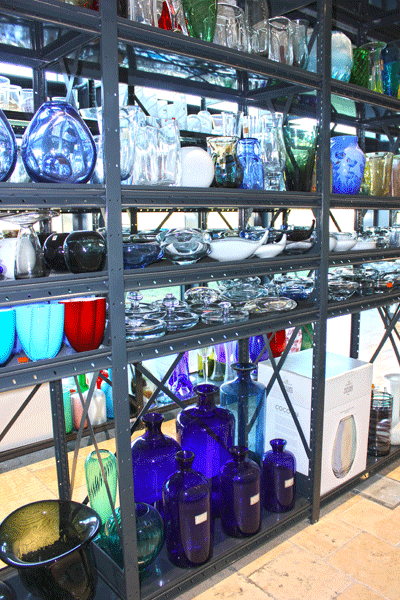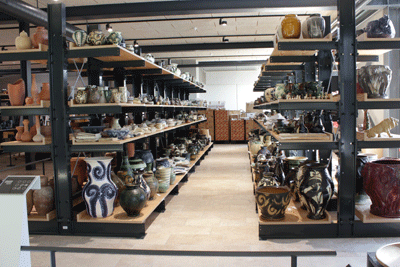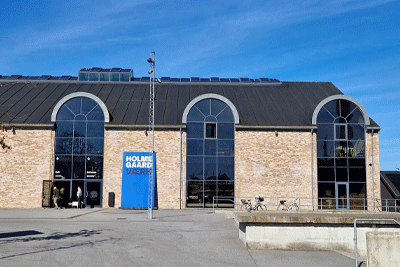Background

The history of Holmegaard Værk began back in 2014 with a desire to preserve the empty buildings of Holmegaard Glassworks. After a couple of years of preparatory work, funding was secured, and the process of issuing tenders and obtaining quotes began. In 2019, work began on renovating the old buildings with a view to opening in 2020.
One of the challenges was the large glass collection, which consisted of an impressive amount of 39,000 pieces of glass. Although the factory had almost 19,000 m2 under roof in the main building alone, there was simply not enough space. Therefore, it was decided to create an open repository and place the glass on shelves specially designed for this purpose.
Another of the collections is the Kähler ceramics, which were donated by Rosendahl when they took over the brand in 2024. This collection has been built up at the museum over many years, and as Kähler also originates from the Næstved area, there has been a natural partnership over time. Here, the decision was again made to create an open repository, this time using cantilever racks.
The solution
Glass collection
The solution is designed as a mezzanine solution with a floor, first and second level. On first and second level, the floor consists of grating to ensure good circulation. The upper levels of the shelving are accessed via a staircase at one end of the installation.
The basic elements are Hi280 galvanized steel shelving, coated with RAL Gray 7016. The special feature of this RAL color is that it is the base color of the entire Holmegaard Værk structure.
The shelving system is 40 meters long with frames reaching a height of 7.5 meters. 944 shelves, each 1 metre long, provide a total of 1,100 shelf meters.
In a warehouse, you will often have a system for keeping track of storage locations. Here at the museum, each piece of glass has a number that is paired with a number system in the museums' shared database.
Ceramics collection

In this open repository, the solution consists of 4 double-sided cantilever racks with a total of 31 columns. Each column is 2.5 meters high with 4 levels. The arms are 600 mm long, installed without an incline and fitted with chipboard shelves. The load capacity per arm is 500 kg, which some of the ceramics reach.
Technical manager Carl-Henrik Hansen explains: “When we had to choose a shelving system for the glass collection, I drew on my experience with industrial shelving. I imagined that we could start with standard shelving and then paint it in our RAL color. The same applied to the cantilever racking, which was perfect for the purpose. The only thing we changed was the slight inward inclination of the arms, as we needed a flat shelf”
The execution
Fitting 39,000 pieces of glass into the shelving was no small task. It quickly became clear that the conservator would not be able to do it alone before the opening. Fortunately, Holmegaard benefits from a good many enthusiastic volunteers – former employees – who made themselves available.
The glass was transported from temporary storage to Holmegaard Works, where the conservator ensured that it was unpacked. The volunteers have experience handling glass, so over a period of two to three months, the glassware was put in place on the shelves. The ceramics collection was set up by both the permanent staff and the volunteers, but this was a more manageable task.
Carl-Henrik Hansen elaborates: “It wasn't just during the setting up of the glassware that we got help from our volunteers. They were already involved in the entire process of registering all the glassware. But when the actual installation of the shelves presented some challenges and delayed the setting up of the glassware, it was fantastic to be able to call on them so we could get the job done. To be completely honest, the last pieces of glassware were not put in place until after the opening, but I don't think anyone noticed.”
The result

The decision to choose an open repository for both glass and ceramics has proven to be the right one, five years after opening. Carl-Henrik Hansen explains: “There's no doubt that particularly, the glass shelving takes people's breath away, but the solution of having two open repositories has proven to work really well. Many of our guests think that the multitier shelving solution was built for the room, not least because of the light coming in from outside, but that's not the case. In fact, the room was built back in 2006 at the same time as the main building, but it was never used.
The collection of both glass and ceramics is expanded from time to time, either when a private collector makes a donation, or when new pieces of glass are produced. The items are then registered and placed on the shelves, as they are also part of the history of the glassworks.
Holmegaard Værk is Denmark's first, last, and only existing glassworks. Between 60,000 and 70,000 visitors come each year to see the exhibition and working museum, which has four glassblowers. Both brands (Holmegaard & Kähler) are owned by Rosendahl.